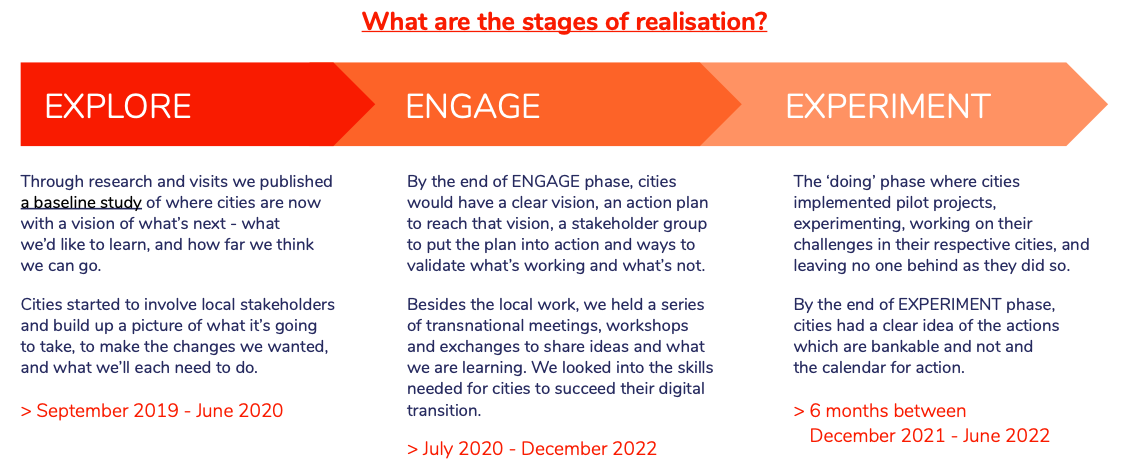Designing the method
Finally, the method should be articulated around this clear understanding of needs, leaving space for learning as new needs arise. The needs analysis should be used to design an initial proposition for how the network might best support this group of cities to achieve their goals. While a learning rhythm should intentionally build in space to learn and adapt as e.g. new needs arise.
Our approach and methods
- Initial proposition: Articulate the method using the insight from the baseline study to support this group of cities to achieve their goals. Share the method with the cities so they can see how the network will support them. Build in some stages of feedback from the cities before finalising the offering.
- Structuring the network in 3 phases: Think about what shift in knowledge, expertise and action the cities need to make to reach the network objectives. For ASToN, we structured the network in the 3 phases of Explore, Engage and Experiment.
-
- Explore: this first phase is for setting the baseline and mapping the landscape. Understand the context for each city and the challenge the city would like to focus on. Define the problem properly and map out the stakeholders from across all sectors and parts of the city who might have influence or resources for addressing the core problem.
- Engage: the second phase is to move from theory to practice and begin building relationships with people from outside the local authority, in each sector that’s affected by or involved in the problem and the potential solution for tackling it. This could be across business, startups, academia, the press, national government or other layers of administration, and most importantly always included citizens
- Experiment: the third phase was the time for city teams to put together all they’d learned up to this point. The true root cause of the problem they’d like to address, an early stage idea for tackling that problem, the people from across the city who could help or would be affected to input into the design and the process, and funding from ASToN and beyond to finance the experiment. All supported by coaching from Innovation Coches and the Technical Experts.
- A rhythm to learn and adapt: consider using a Quarterly rhythm as a drum beat for the network e.g. every 3 months, get feedback, spot any changing needs, and decide on the details of what the next phase should look like (rather than setting out a really clear calendar at the start which will change as things go).

Lessons learnt from ASToN (2019-2022):
• Be flexible with your method and how you design your project. We had initially organised the project in three phases (explore – engage – experiment) intended to be delivered consecutively. Reflecting on Phase 1 of ASToN, we realised that the Experimentation phase should be embedded in the Engagement phase in order to facilitate learning & adapting. Building the best model and running ASToN as effectively as possible was a constant matter of adapting to needs and context, especially given some external unforeseen shocks like COVID19.
• Factor in time to reflect, learn, and course correct. We always gained new insights from putting things into practice and made sure we took time to pause, reflect and learn regularly. We built a method that was modular, with three-month-long cycles of learning together, then pausing, reflecting, course-correcting where necessary before going again.
• Tailor the offering. A method designed on paper can be very far from what the cities actually need once you’ve got to know the city contexts, the teams’ skillsets and mindsets and how they all sit together as a cohort. By tailoring the offering it’s much easier to bring as many of the cities along on the learning and experimenting journey as possible and knowing how far you can stretch and challenge the city teams to test and learn new things.


